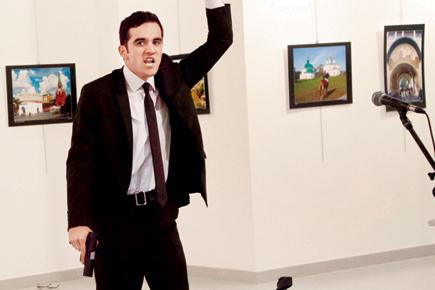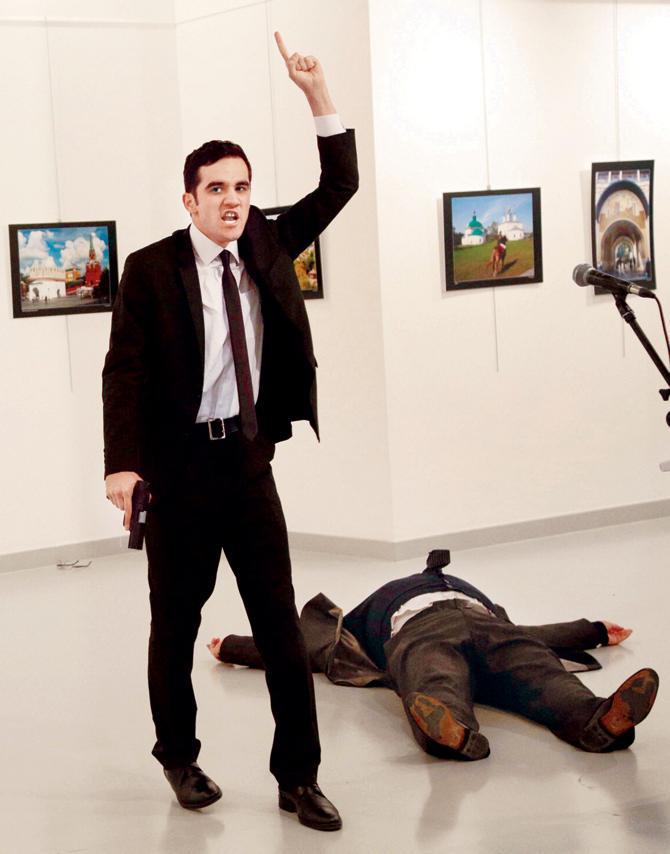As controversy rages over Burhan Ozbilici’s photograph of Russian ambassador Andrei Karlov’s murder, a photojournalist writes about what goes into making an iconic image


The photograph taken by AP photographer Burhan Ozbilici of the murder of Andrei Karlov, the Russian Ambassador to Turkey, at a photo gallery in Ankara, Turkey, on December 19
 This is what we call hard news, perhaps the most compelling and striking aspect of photojournalism. And, most often, such powerful photographs bear witness to history and go on to become iconic images.
This is what we call hard news, perhaps the most compelling and striking aspect of photojournalism. And, most often, such powerful photographs bear witness to history and go on to become iconic images.
ADVERTISEMENT
The impact on the minds of the viewers of such hard-hitting images is undeniable. More often than not, these images adorn the front pages of newspapers across the world and exert a deep influence on public opinion. But, no longer are these images in the realm of professional photojournalism. Before the advent of digital photography, the first people with cameras to arrive on the spot would be professional photojournalists. But with the digitisation and the subsequent democratision of photography, almost every person has a camera of sorts. And in most breaking news situations, amateur photographers present at the location, would be shooting pictures and videos, much before the first professional photographer would arrive on the spot. In fact these days, even people caught in the situation, feel the need to record the moment, before moving to safety. A recent example of this, were the images that emerged from the terrorist attacks in Belgium and France. Some of them went on to become iconic.
Despite the losing battle against the huge numbers of omnipresent amateur photographers, almost every professional photojournalist still craves to be at the right spot at the right time. As these are the images that remain in public memory for long, becoming historic images. In this horrific shooting of the Russian Ambassador in Turkey, the AP photojournalist happened to be at the spot and managed to capture the murder in all its shocking yet captivating power.
I can’t speak on behalf of other photojournalists on what they experience while confronting and capturing such situations on film, but I can say these are heart racing moments and it’s not just due to the danger that surrounds the photographer at that moment. In similar situations, I remember feeling the initial emotion of fear and anticipation. But it would oft be overshadowed by the realisation of the enormity of the moment that I am capturing on film. While it is very easy to get carried away with the moment, exposing oneself to enormous risk, it is important for a photojournalist to stay calm and rational. The risk associated with such coverage should always be top priority for every photojournalist and it is only a calm mind and quick risk assessment that keeps us safe. However, it is the single-minded obsession of a photojournalist to capture the moment, that makes him or her overcome fear of personal harm and take certain risks.
Unfortunately, this firefly like attraction to capturing hard news has proven fatal for even seasoned photographers. It is this obsession that changes regular ordinary people into extraordinary photojournalists. And, this is why I maintain that the ‘c’ word that differentiates professional photojournalists from amateur photographers is not ‘creativity’ but ‘courage’.
It is unfair to subject photojournalists, who are doing their work, sometimes risking their own lives, to unnecessary ethical and moral scrutiny. It is very easy to sit on the sidelines and be critical of the photographers, who are foot soldiers in the thick of action, recording events for perpetuity, without any agenda or bias. And, unlike yesteryears, it’s most likely that these images won’t be winning awards anymore, as this is no more the domain of just professional photojournalists. Increasingly, it’s going to be the complete newbie with a cell phone camera who is going to be capturing such stark hard hitting images. Photojournalists are too far outnumbered by amateur shooters. It wouldn’t be inaccurate to say that almost every other person these days has become a photographer of sorts.
Till the last millennium, most of what we learnt in our history books was in words. But more and more history is now being recorded visually. Digital photography has made cameras and amateur photographers omnipresent. And, reactions to such striking images is natural, where the image itself overtakes the gravitas of the situation. And the same has happened in this gruesome murder. The different angles of the photographs taken are being discussed more, rather than the political ramifications of the murder, which is of far more importance. But it’s a natural human reaction and the photographer is in no way responsible for this lopsided discussion. Any image would obviously be first discussed on social platforms for its visual content, especially of this compelling nature. But, it need not take away from the larger and more meaningful discourse which would follow, beyond social platforms, once the initial shock of the image wears away. The agenda in journalistic and political circles would be quite different from the reaction of the people on social platforms. Even if these photos of the murder didn’t exist, it would not have made any difference to the political consequences. And, I am sure, politicians or political commentators are not debating the photos, which on the other hand have gone viral on social networking platforms. It’s not that the discourse on social media is frivolous, but it just has a different priority. However, sometimes these lines blur.
Social media can exert tremendous influence on political agenda and decision making, like the overwhelming public reaction to the photo of Elan, the young son of a migrant lying dead on a beach in Greece. That one photo made European nations reconsider their policy towards migrants. Such is the power of a single photo. And more than anyone, it is the photojournalist who understands this power and responsibility that comes with the camera, which drives him to take extraordinary risks, to bring these images to drawing rooms of people.
Arko Dutta is a photojournalist, recognised most for his coverage of the 2002 Gujarat riots for which he won the World Press Photo of the Year award in 2004. He currently runs the Udaan School of Photography
 Subscribe today by clicking the link and stay updated with the latest news!" Click here!
Subscribe today by clicking the link and stay updated with the latest news!" Click here!







